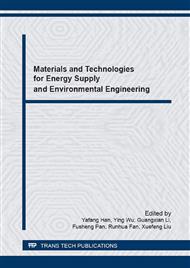[1]
Building Energy Saving and Technology Department of Housing Ministry in Heilongjiang Province, Promote building energy efficiency vigorously and construct resources saving society, J. Information of China Construction. 19 (2012) p.18.
Google Scholar
[2]
B. Z. Qian, J. F. Zhu, Technology Progress of Thermal Insulation Materials of Building Energy Efficiency, J. Building Energy Efficiency. 37 (2009) p.56.
Google Scholar
[3]
L. Gustavsson, A. Joelsson, R. Sathre, Life cycle primary energy use and carbon emission of an eight-storey wood-framed apartment building, J. Energy and Buildings. 42 (2010) 230-242.
DOI: 10.1016/j.enbuild.2009.08.018
Google Scholar
[4]
C. Scheuer, G. Keoleian, P. Reppe, Life cycle energy and environmental performance of a new university building: modeling challenges and design implications, J. Energy and Buildings. 35(10) (2003) 1049-1064.
DOI: 10.1016/s0378-7788(03)00066-5
Google Scholar
[5]
J. Kneifel, Life-cycle carbon and cost analysis of energy efficiency measures in new commercial buildings, J. Energy and Buildings. 42 (2010) 333-340.
DOI: 10.1016/j.enbuild.2009.09.011
Google Scholar
[6]
A. Audenaert, S. H. De Cleyn, M. Buyle, LCA of low-energy flats using the Eco-indicator 99 method: Impact of insulation materials, J. Energy and Buildings. 47 (2012) 68-73.
DOI: 10.1016/j.enbuild.2011.11.028
Google Scholar
[7]
X. Su, X. Zhang, J. Gong, Inventory analysis of LCA on steel and concrete-construction office buildings, J. Energy and Building. 40 (2008) 1188-1193.
DOI: 10.1016/j.enbuild.2007.10.016
Google Scholar
[8]
H. J. Wu, Z. W. Yuan, L. Zhang. J. Bi, Life cycle energy consumption and CO2 emission of an office building in China, J. The International Journal of Life Cycle Assessment. 17 (2012) 105-118.
DOI: 10.1007/s11367-011-0342-2
Google Scholar
[9]
Y. Chang, Y. W. Wang, Life-Cycle Energy Analysis of Urban Residential Buildings in China, J. Journal of Engineering Management. 24(4) (2010) 393-397.
Google Scholar
[10]
S. Liang, Analysis on Optimization of External Wall Structural System of Residential Buildings Based on LCA, J. Building Science. 26(12) (2012) 97-101.
Google Scholar
[11]
Beijing Planning Commission, DB11/891-2012, Design Standard for Energy Efficiency of Residential Buildings, Beijing Architectural Design Institute, Beijing (2012).
Google Scholar
[12]
Z. Li, The Life Cycle Assessment of External Thermal I nsulation Composite Systems Based on Two Kinds of Materials, Master's thesis, Beijing University of Technology (2014) P. 26.
Google Scholar
[13]
M. H. Fang, The Life Cycle Assessment of Typical Wall Materials, Master's thesis, Beijing University of Technology (2013) P. 35.
Google Scholar
[14]
CNMLCA (Centre of National Material Life Cycle Assessment), Material Life Cycle Assessment Database—Sinocenter. Beijing University of Technology (BJUT), (2013) http: /cnmlca. bjut. edu. cn/database.
Google Scholar
[15]
S. P. Wang, Life Cycle Assessment of Several Traditional Building Glass Windows, Master's thesis, Beijing University of Technology (2014) P. 75.
Google Scholar
[16]
M. L. Zhao, Life Cycle Assessment of Concrete Structural Components of Dwelling, Master's thesis, Beijing University of Technology (2013) P. 75.
Google Scholar
[17]
ISO, ISO 14040: Environmental Management - Life Cycle Assessment - Principles and Framework, International Organization for Standardization, Geneva, Switzerland (2006).
DOI: 10.1065/lca2005.03.001
Google Scholar
[18]
X. H. Di, Several Fundamental Researches in the Life Cycle Assessment for Mineral Resources and Materials, Doctor Dissertation, Beijing University of Technology (2005) P. 67.
Google Scholar
[19]
Tsinghua University, Designer's simulation toolkits (DeST-h), Tsinghua University, Beijing (2004).
Google Scholar
[20]
B. Peng, Case Study on Life Cycle Energy Consumption and CO2 Emissions of Green Buildings, Master's thesis, Tsinghua University (2012) 53-57.
Google Scholar
[21]
PRé Consultants, Simapro 7. 2. 2 Amersfoort, the Netherlands, PRé Consultants (2013).
Google Scholar


